How to Build a Pond Step-By-Step (With Pictures)
Pond Academy is reader-supported. Buying through links on our site may earn us an affiliate commission. As an Amazon Associate I earn from qualifying purchases.
If you're looking for a great way to enhance the beauty of your landscape, a pond is a fantastic choice.
There are many different types and sizes of ponds that can be constructed - from small water gardens with just a few inches of water up to large farm ponds or a small lake.
In this build, we will meet somewhere in the middle with a stunning, average-sized backyard pond using a preformed pond liner (though you could easily use a flexible pond liner, as well).
How to Build a Pond Step-By-Step
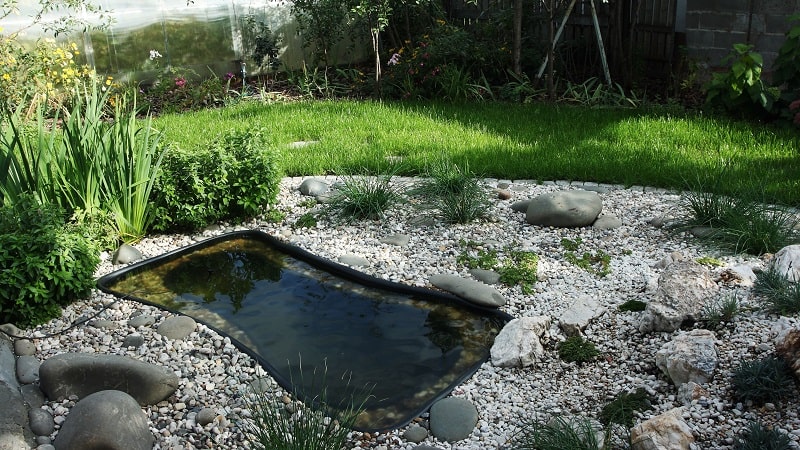
This step-by-step guide with pictures can be used to build a:
- koi pond or a fish pond
- small pond
- waterfall pond
- natural pond
- duck pond
- turtle pond
- fountain pond
Or any type of small to medium-sized backyard pond you can think of.
And you don't need to be an experienced pond builder either, as this build was designed to be an easy DIY project for all skill levels!
Let's get started!
Materials Needed
These are the materials you will need to build your own pond, complete with a pump and filter.
- Preformed pond liner (you can easily modify the steps below for a flexible pond liner if needed)
- Pond pump
- Leveling sand
- Level
- Shovel
- Wheelbarrow
- Marking stakes
- Edging of choice (pebble rocks, gravel, stones, bricks, etc.)
- Optional: Floating pond plants like water lilies and a pond filter
Step 1: Choose the Location for Your Pond
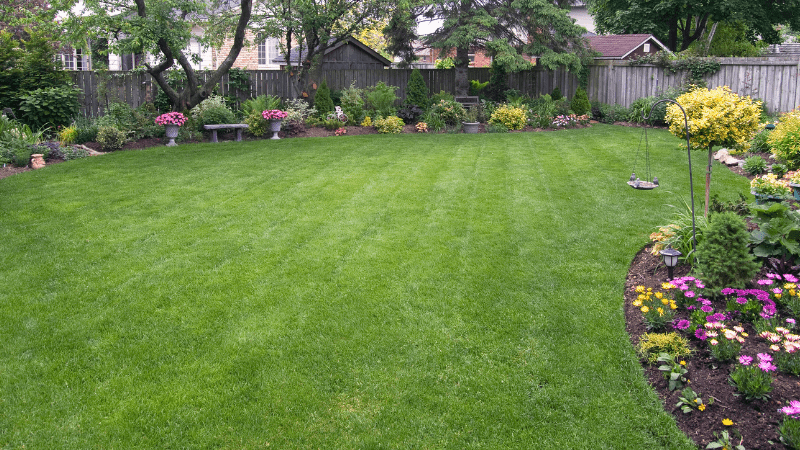
While you can build a pond in just about any location in your backyard, certain spots will make installation and maintenance easier and create a healthier ecosystem in your pond.
Tips for choosing the best pond location:
- Your pond should be placed on flat ground with a minimal slope.
- If you add powered water features like a pump, fountain, lights, etc., you may want to place it near an electrical outlet.
- Make sure your garden hose will reach your pond.
- Place in a location that gets at least 6 hours of sunlight per day.
- Leave plenty of workspace around the entire pond so you can easily care for it once it's complete.
- Ideally, you don't want your pond near trees. The closer it is to trees, the more leaves, sticks, seeds, etc. you'll need to fish out of your pond. Plus, growing tree roots can potentially ruin your pond liner, and they are a pain if you hit a root in the digging process of building your pond.
Once you've found the perfect spot, we can start building!
Step 2: Mark the Pond
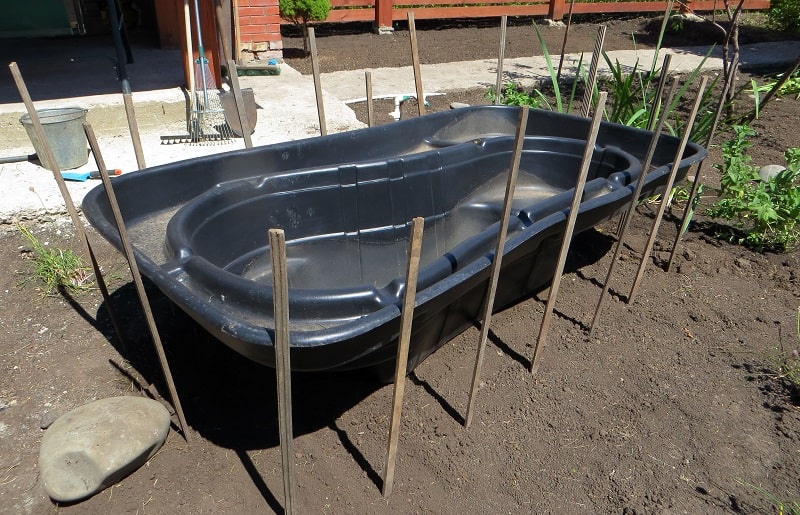
Place the preformed pond liner down in your chosen location. Stake the outside edge of the pond with your marking stakes.
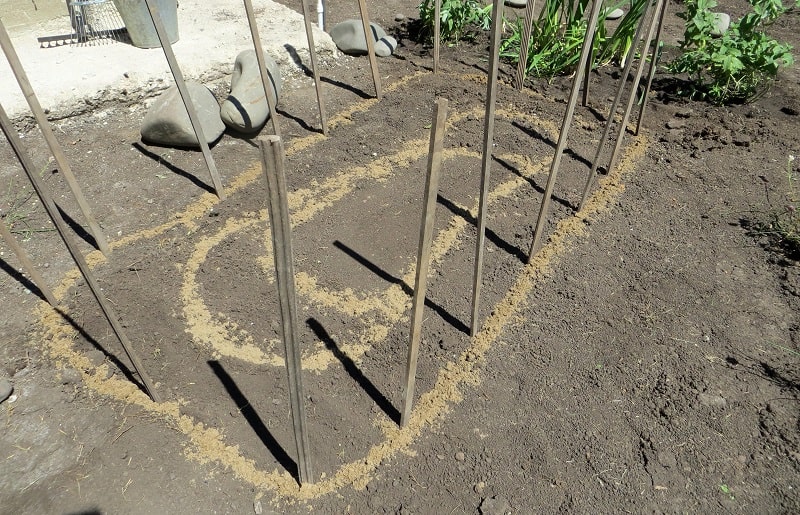
Use the leveling sand (or spray paint) to mark the outside edge of the pond liner, as well as, any tiers or shelves your pond liner has.

Remove the marking stakes. You now have your outline and are ready to dig!
Step 3: Dig the Pond
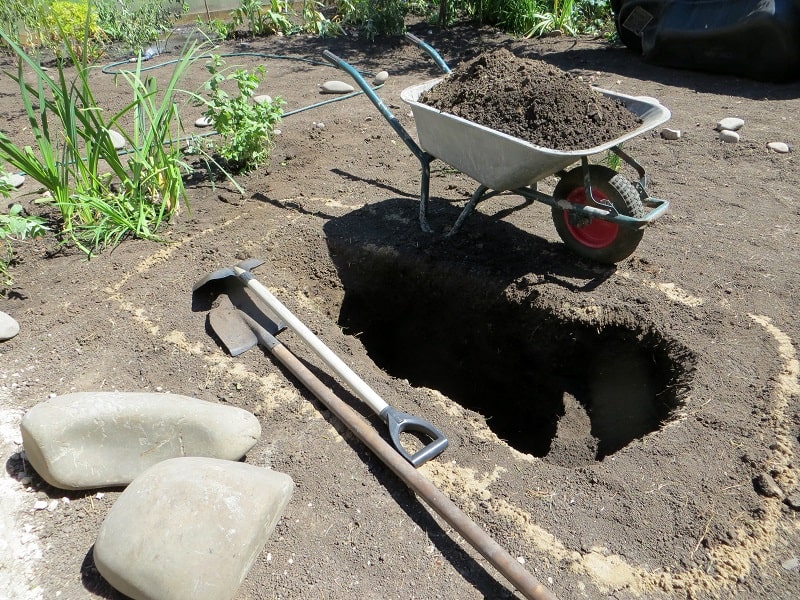
Using your shovel (or small excavator depending on the pond size), remove the dirt, starting at the innermost tier (the deepest part of the pond). Be sure to account for the proper depth of the pond liner.
![]() Tip
Tip
The hole should be a few inches deeper than the pond liner itself as we will be adding a 2" sand layer later in the build process.
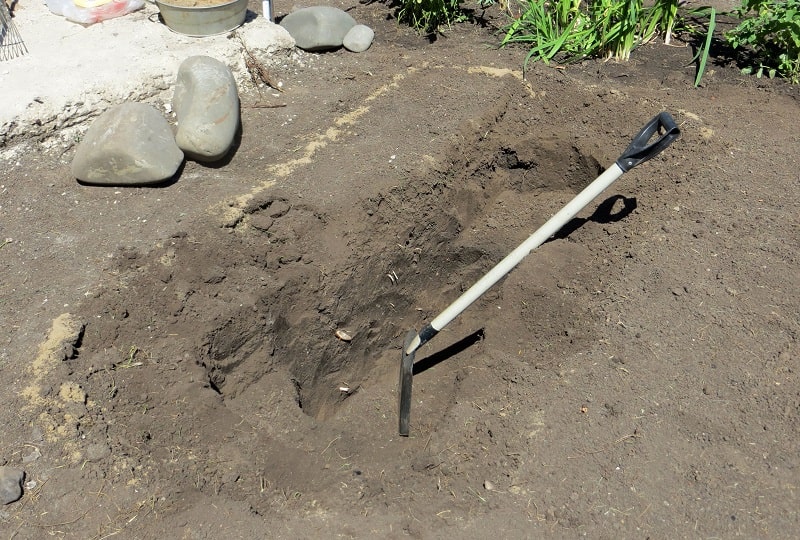
Continue digging out each tier. A wheelbarrow comes in handy if you need to move the dirt a long distance.
![]() Tip
Tip
You can use the dirt to create a mound next to your pond for a waterfall or just a landscaped hillside.
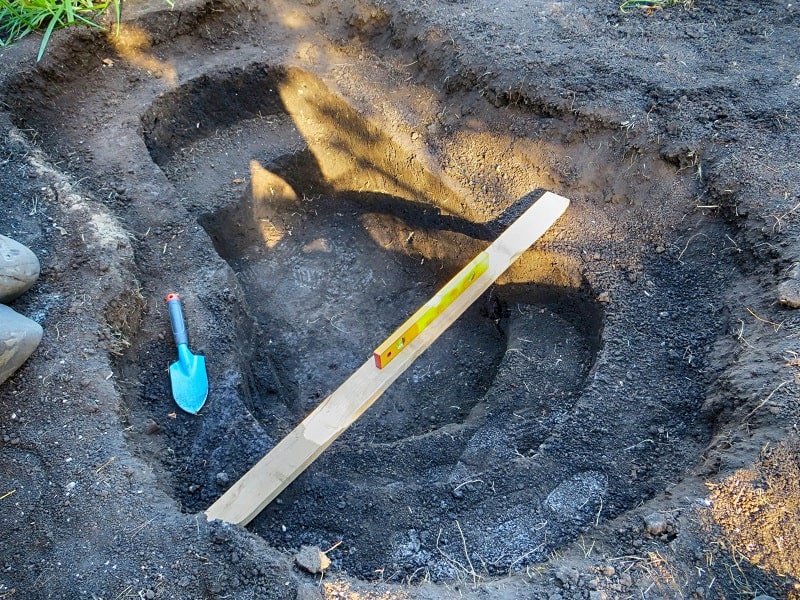
Check to make sure the tiers are level. If your level isn't long enough, lay down a 2x4 (or similar) across each tier and place the level on it.
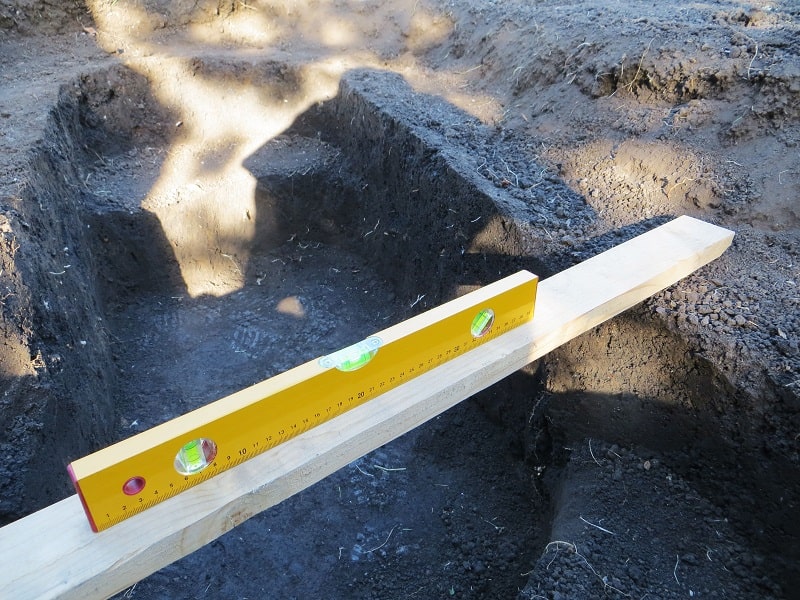
They don't need to be perfectly level at this point as I cover that in the next step, but they should be close.
![]() Tip
Tip
Make sure there are no sharp rocks in the hole that could puncture the liner.
Step 4: Level the Area With Sand
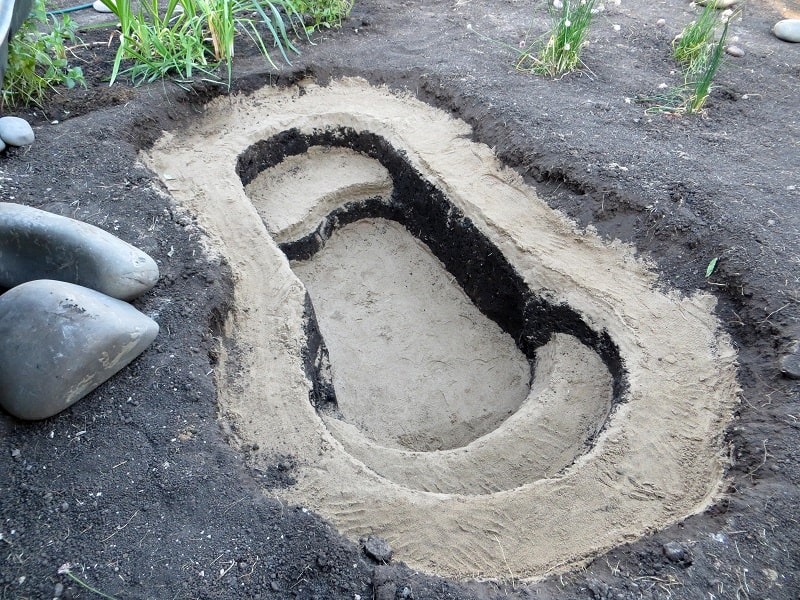
Once the pond hole has been completely dug out, we need to add a 2" layer of sand in the hole, covering each tier.
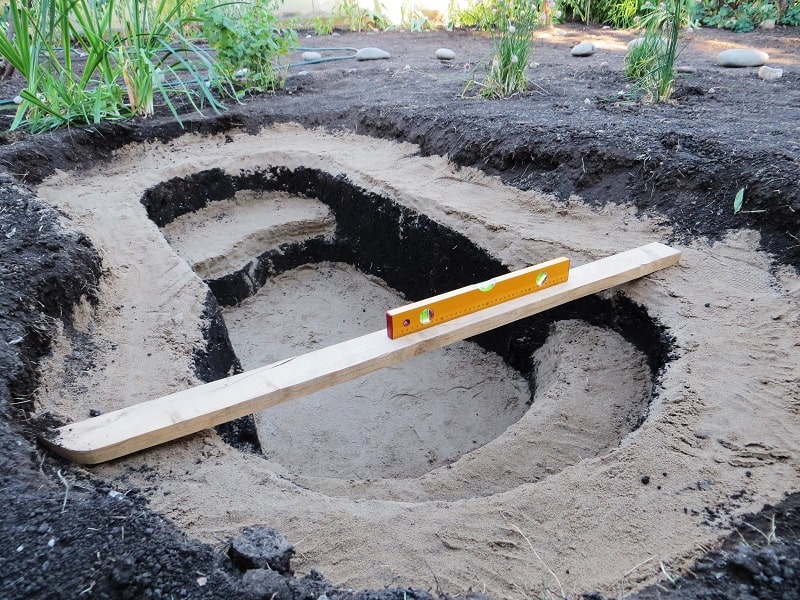
Again, make sure everything is level.
Step 5: Install the Preformed Pond Liner
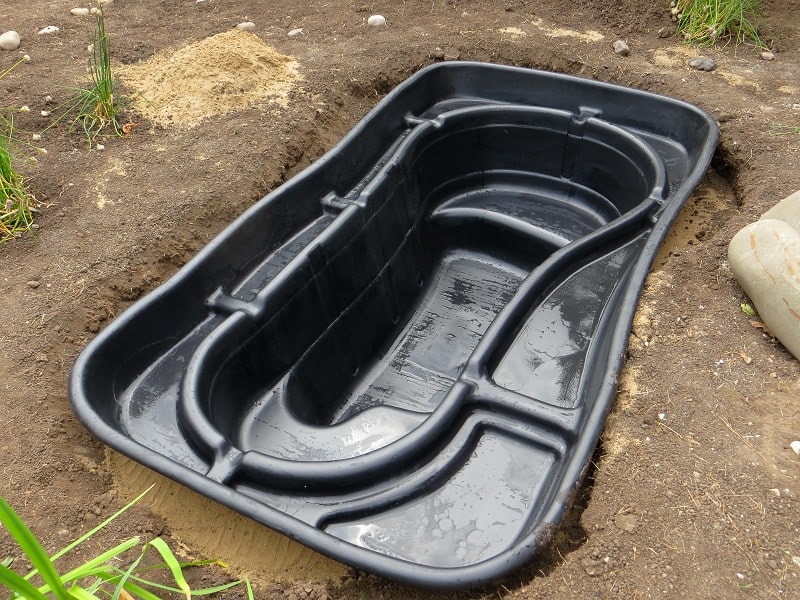
Carefully position the pond liner in the hole. Ensure that it is level.
Step 6: Fill Pond Halfway
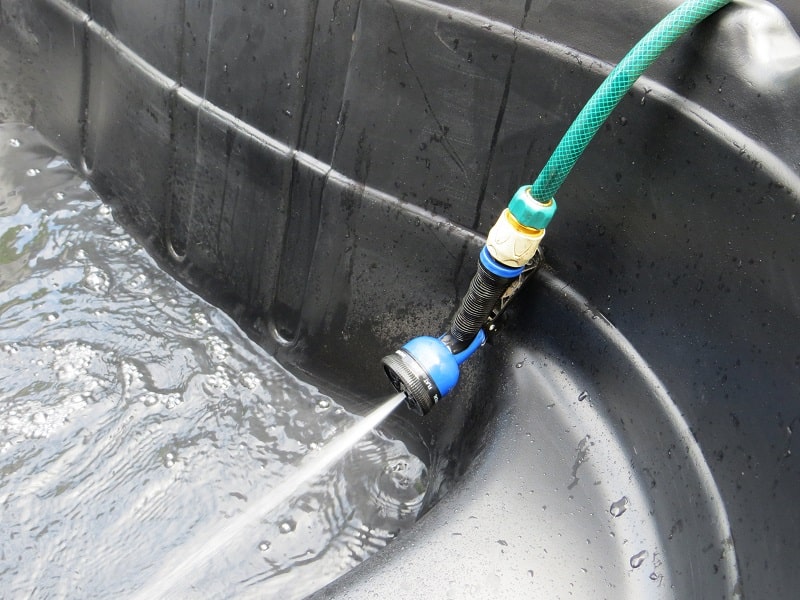
At this point, I like to fill the pond about halfway to test how the liner reacts. I want to make sure everything stays level, there are no leaks, and that no folding or creases form in the liner due to weak spots in the foundation.
![]() Tip
Tip
Don't skip this step! Improper installation of a preformed pond liner is the number one cause of leaks.
If all checks out, we can continue!
Step 7: Add Pump and Filter
If you are adding a pond pump, fountain, and/or pond filter, you can place them in your pond now.
A fountain, bubbler, or waterfall will help supply essential oxygen to your pond and keep the water from becoming stagnant.
A filter will help keep your pond water clean and clear. And may even be needed if you add fish to your pond.
And a pond pump is what powers your fountain and filter.
![]() Tip
Tip
Be sure to follow the manufacturer's directions to properly install these components.
You can now fill the rest of your pond with water.
Step 8: Landscape Around the Pond
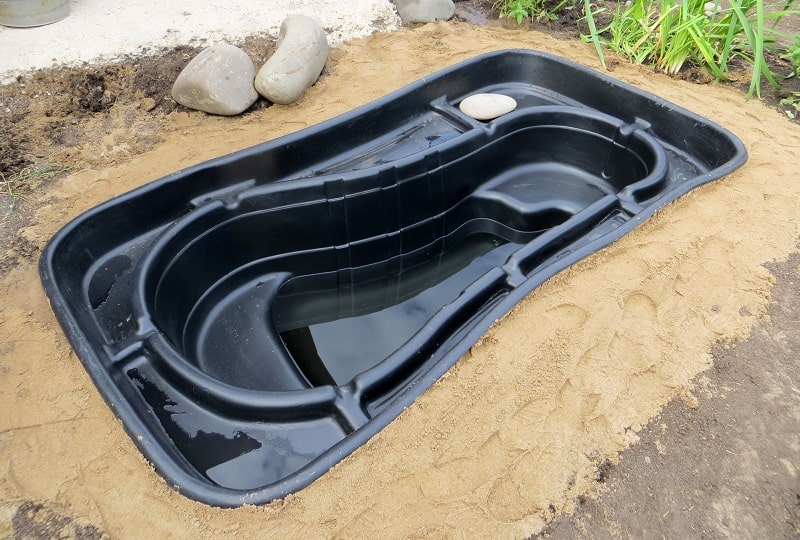
Start by using your leveling sand around the edge of your pond, creating a seamless transition from the pond's edge to the ground.
Adding landscaping is an art in and of itself, so use your imagination and create the pond landscape of your dreams! Check out these pond edging ideas for inspiration.
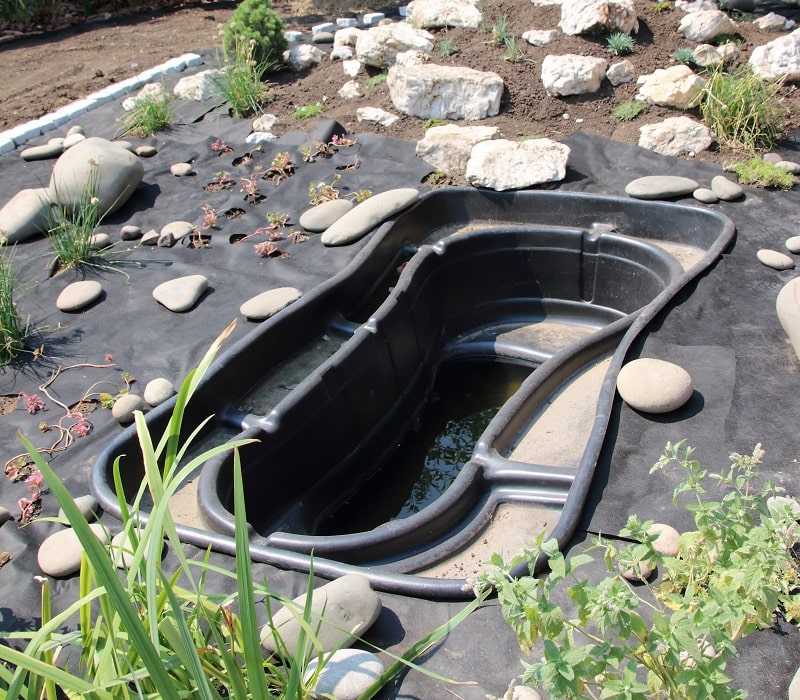
For example, you could start by laying down landscaping fabric around your pond. Use large rocks or stones to hold it down.
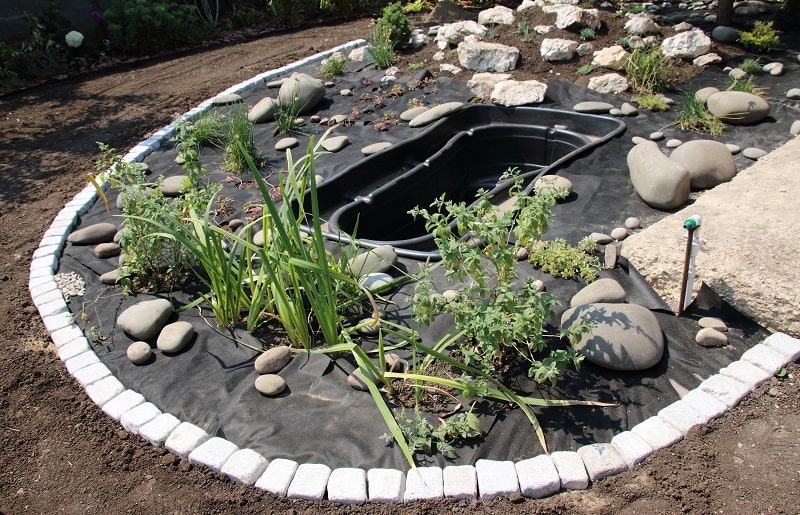
Add a brick or stone edging around the pond area.
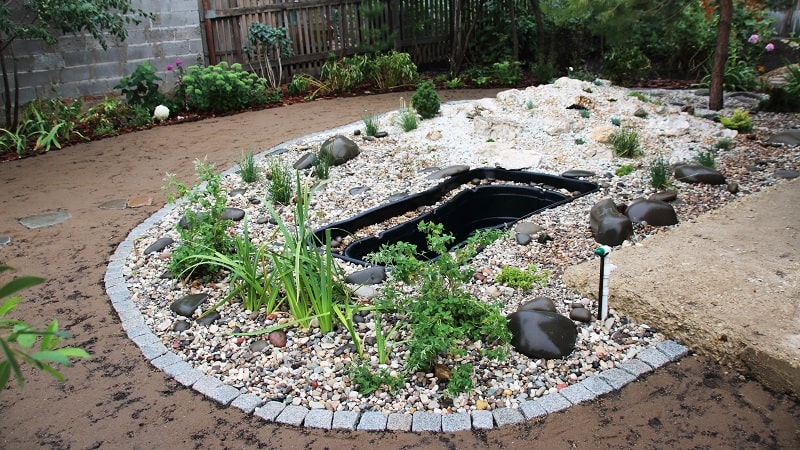
Fill in the area between the pond's edge and the brick edging with pebbles, plants, statues, lighting, or other pond decorations.
You could spice things up and help oxygenate the water with floating pond plants like water lilies, as well.

And that's it! You have just built yourself a beautiful homemade pond!
Check out our pond maintenance section to learn how to care for your new pond.
Get Our Best Pond Tips Sent to Your Inbox for Free!
Join thousands of others and learn from our decades of pond building and maintenance experience! Your pond will thank you!
By subscribing you agree to receive emails from PondAcademy.com. We will always respect your privacy and you can unsubscribe at any time.
Tips for Successful Pond Building
Before putting your shovel to dirt, let's look at a few tips that will help ensure your new pond build is a successful one.
- Choosing the right location: We already covered this in step one above, but it's worth repeating. Picking the right location can make your life much easier when it comes to maintenance. Plus, it can dramatically improve the health of your pond or water garden.
- Digging can be hard work: Don't underestimate the amount of labor involved in digging a hole for your pond. Physically, this will be the toughest part of the pond build. So, if needed, employ the help of friends or a professional when it comes to digging the hole.
- Proper pond depth: Make sure your pond is deep enough if you plan on having fish in it. At least 24 inches deep is the bare minimum, and in colder regions, you will want to go deeper to ensure your fish survive winter.
- Proper filtration: Again, this is especially important if you have a fish pond. Fish excrement, uneaten food, pond plants losing leaves or roots, and organic debris blowing into your pond can cause all sorts of water quality issues. Installing a filtration system properly sized for your pond will help keep it clean and clear.
- Plan electrical beforehand: If you plan on using electrical-powered devices like pumps or lighting in your pond, it's good to have an idea of how you're going to power them before digging your pond. Whether that be installing an electrical outlet near your pond, running an extension cord, etc.
Additional Information
Do You Need a Permit to Build a Pond in Your Backyard?
You may need a permit for a pond depending on local laws, and the size and location of the pond. In some areas, governing bodies require the same permits for ponds as they do swimming pools. Other areas have height restrictions on raised ponds and some require ponds to be a certain distance away from your house.
Unfortunately, there's no one size fits all answer. It's recommended to check with local city officials or the building department to see if a permit is required in your area.
![]() Tip
Tip
Call 811 and have your yard marked for any hidden utilities so you don't accidentally dig through a power line!
How Much Does It Cost to Build a Pond?
Building a backyard pond will cost on average between $100 - $5,000 and up. Of course, there are a variety of factors that will influence pond construction costs including the size of the pond, the materials used, and whether you do the work or have it hired out.
Our pond build above can be completed for around $500, depending on the pump and filter you use and your landscaping choices.
How Deep Should I Dig a Pond?
A backyard pond should be a minimum of 2 feet deep and deeper if you plan to add fish and aquatic plants. And if you live in colder regions you may want to go deeper to prevent the pond from completely freezing over.
Can You Build a Pond Without a Liner?
While you'll probably want to use a pond liner for simplicity sake when building a typical backyard pond, there are ways to build a pond without a liner, including:
- Excavating in impermeable soil
- Using a cement foundation
- Using bentonite or chemical additives
Can You Just Dig a Hole for a Pond?
If you are digging a hole for a pond in impermeable soil, then yes, you can just dig a hole and not use a liner. If you're building a typical backyard pond, I would recommend using a liner to be safe. Plus, a liner will make it easier to keep your pond clean and clear.
How Far Should a Pond Be From a House?
Legally, you'll need to check with your local building department to see if there are any rules and regulations pertaining to the distance from your house. Aside from that, you'll need to ask yourself if you want to hear the sounds of the waterfall, fountain, or wildlife (frogs can be very loud), and enjoy the pond's beauty from your back patio or deck.
If there was a resounding yes for the above, then the closer the better!
Should Ponds Be In the Sun or Shade?
Ponds should be in both sun and shade! Ideally, your pond should be in a spot that gets at least 6 hours of sunlight per day. This will help your pond plants flourish and bloom.




